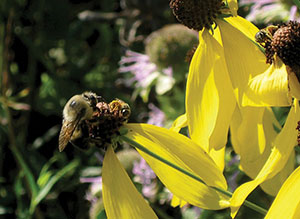An Introduction to Beneficial Organisms and Habitat
 |
|
Two bees share a flower of Ratibida pinnata, yellow coneflower. Source: C. Neal, UNH Cooperative Extension |
Scientists are spreading the word about how farmers, gardeners, homeowners, and land managers can cultivate rich habitats for beneficial organisms and suppress pests.
This issue of IPM Insights is dedicated to the ways people from all walks of life can promote beneficial organisms and habitat. Margaret Skinner of the University of Vermont has been working for many years in this area, and in particular has done recent work on banker plants in hoop houses—in other words, cultivating the types of plants on which natural enemies of pests will gather and reproduce in the outdoor structures used for growing crops. Likewise, Paula Shrewsbury of the University of Maryland has been working on habitat to increase beneficial organisms. We devote some time to each of these scientists.
Pollinators and Beyond
When people think of beneficial organisms and habitat, they might think of recent popular reports in the media about pollinators. Amid this interest, in 2014 the Northeastern IPM Center awarded $17,100 to Amy Papineau of the University of New Hampshire to lead the Northern New England Pollinator Habitat Working Group. This working group is collaborating on methods to protect pollinator habitat in northern New England. They are protecting existing habitat on farms, roadsides, and natural areas, and planting new flowers that are beneficial to pollinators.
Indeed, pollinators are one important aspect of the picture, but there’s a much larger world of living organisms and practices to maintain a diverse habitat to promote and increase the numbers of beneficial organisms such as lacewings, ladybugs, and hover flies, all of which can suppress pests on farms and in gardens, as well as around residences and in natural areas. Let’s examine the example of high tunnels where commercial crops are grown.
Cultural Practices
Rose Ogutu of Delaware State University writes that cultural practices such as maintaining a diverse variety of disease-resistant plant types is key to managing pests, especially in high tunnels. “Practice crop diversity, crop rotation, including banker plants,” she recommends.
Skinner suggests using IPM practices such as using indicator plants. An indicator plant is a type of plant that attracts pests to a site where natural enemies may attack them. In addition to trap plants and banker plants, she suggests using nectar/pollen/habitat plants, which promote various ecosystem functions.
“Now plants are being used to serve several of these functions at once, particularly in greenhouses where plants or plant stages supportive to natural enemies may be rare,” Skinner wrote in the introduction to a presentation about IPM and guardian plants in greenhouses.
If the greenhouse is a microcosm of the natural world, then this issue of IPM Insights is all about scaling these practices and thinking to the larger world—to entire farms, gardens, homes, and tracts of land. In each of these settings, people from any background can learn IPM techniques to promote beneficial organisms and suppress pests.
— by CHRIS GONZALES
The Northeastern IPM Center promotes integrated pest management for reducing risks to human health and the environment. If republishing our news, please acknowledge the source (“From Northeast IPM Insights”) along with a link to our website.
